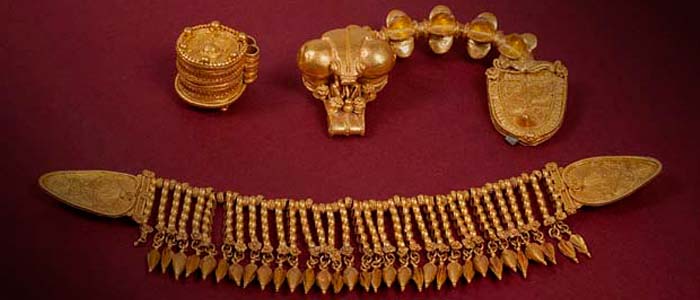
This collection covers the period in world history known as the Hellenistic. Although the exact beginning and ending of the period remain obscure, usually for the chronological framework the death of Alexander the Great in the year 323 BC is taken as the beginning. The fall of the last Hellenistic kingdom of Ptolemy in the year 31 BC is considered to mark the end. Although the territory of the current Republic of Macedonia fell under Roman rule in the year 168 BC after the battle of Pydna, because the material culture continued the old Hellenistic traditions, the fall of the Ptolemaic kingdom is accepted as the end of the period. Within this chronological framework, on the territory around the eastern Mediterranean, a new Hellenistic era began.
Hellenistic culture is a combination of three cultural components from the ancient world: Macedonian, Hellenistic, and Eastern or Oriental. Because this culture did not have permanent territorial borders and given the fact that its disintegration began before its final development, this period is one of the most complex and at the same time one of the most interesting periods, not only in antiquity but in the entire sweep of human history.
Most of the artifacts that belong to this collection come from the site of Isar-Marvinci, Valandovo. This site and ancient Lihnid (Ohrid) are the best investigated sites from this period in Macedonia. A certain emphasis is put on artifacts discovered at the site of Vardarski Rid and in the Pelagonija, Tikvesh, Povardarie and Skopje regions.
In the permanent exhibition, Hellenistic archaeological material is grouped and presented according to its function and the material of which the artifacts are made. A special accent is put on gold jewelry, which was decorated luxuriously with the filigree and granulation techniques of the goldsmiths, and also by adding semi-precious stones or colorful inserts, techniques that in this period were carried out to perfection. Among the pottery, imported vessels from famous ceramic centers especially stand out, but locally made vessels were also no exception, because they were made following the example of the famous centers, which dictated the latest fashion trends. Pottery vessels are divided into sets for storage and consumption of wine and other liquids and toilet sets, as well as dishes for everyday use in the households. Among the vessels, the most important are those made of bronze (situla, oenochoe, lebes, olpe, kantharos and others), which are numerically less well represented than the pottery; this situation is understandable because in antiquity bronze was a very expensive raw material. Weapons are represented by the artifacts showing the armament of a Macedonian warrior and of a warrior who is not typical for this region, but who actively participated in wars in these parts, probably as a mercenary. That is the Celtic military equipment, discovered in grave number 58 in the ancient necropolis at Lihnid.
Among cult images, the largest collection of terracotta figurines from this period in our country stands out; those are the terracotta figurines that were discovered at the site of Isar-Marvinci. They are followed by the representations of Aphrodite from Vardarski Rid and Isis from Lihnid (Ohrid) made of marble or alabaster; both figures are excellent examples of the sculptural skill of master craftsmen of that time. The images of the Phrygian mother-Cybele are also mentioned; they come from different sites and thus show the undoubtedly great respect for her cult in these regions. Among cult images, the miniature figurines made of bronze and dedicated to Daedalus, Isis-Tyche, Dionysus and others also stand out.
In the exhibition are presented artifacts for everyday household use, such as loom weights, scissors, needles and other tools, which are helpful for reconstruction of the daily life of a person in the Hellenistic period. By including all these artifacts for very different purposes, the main aim is to present a complete picture of this important period in human history.
M.A. Pero Ardzanliev, custodian advisor for Hellenistic period
perekutika@yahoo.com








